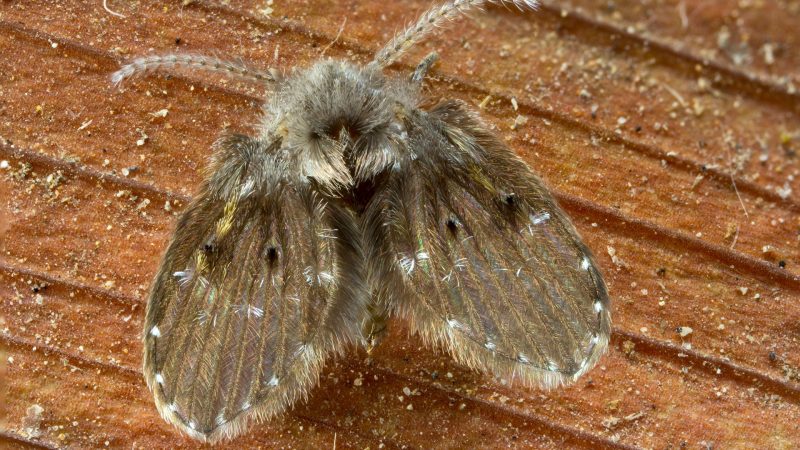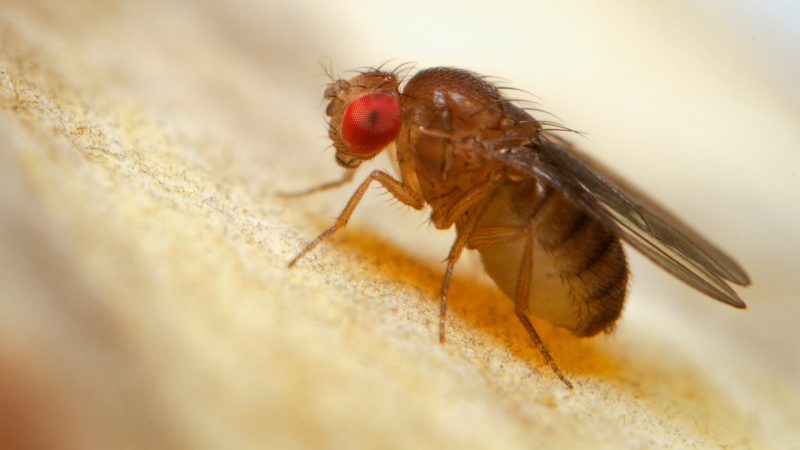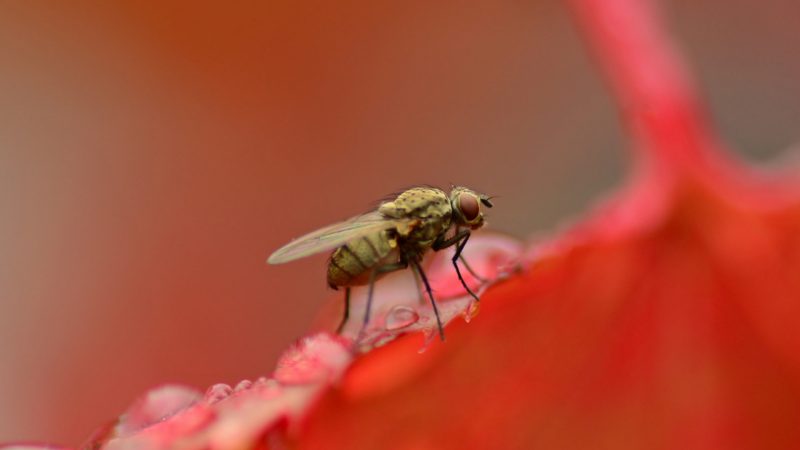Small black flies in the kitchen could be phorid, drain, or fruit flies. Thus, it’s best to identify the fly type you’re dealing with to get rid of them.
How to get rid of the small black flies in your kitchen? The best way to eliminate them is by removing their food source and breeding areas. This way, you can control their growth and deter them from going back and forth from your place. You can also use an apple cider vinegar trap to get rid of these small black flies effectively.
But, before doing anything mentioned above, identify the type of fly you’re dealing with to deal with the problem effectively.
Why Are There So Many Small Black Flies in Your Kitchen?
If you’ve spotted many small black flies in your kitchen, it could be that you have food debris in your kitchen bin. These little pests find their way into homes through fruit and vegetables.
They usually breed in ripe flesh and skins of fruits and vegetables then lay their eggs on the food debris in your kitchen or compost bin. Thus, it would be best if you cleaned up your countertops after peeling fruits and vegetables to prevent attracting these tiny black pests.
Small Black Flies | Identification, Habitat, and Behavior
There are several types of flies that have a habit of invading kitchens. However, the most common are drain flies, fruit flies, phorid flies, and fungus gnats.
Related: Little Black Bugs That Bite | Identification, Habitat, and Behavior
Drain Flies

Identification
Drain flies are moth-like flies that typically hang out around the drains. They commonly go by the nicknames moth flies or sink flies. They have a similar size to fruit flies and gnats—about 2 mm and 5 mm.
You can identify them with their round, fuzzy bodies and tiny, moth-like wings. Their colors also differ from other house flies, ranging from pale gray to black.
Although these pests look like moths, they’re not capable of flying far. You might notice them making large hops instead of buzzing around your kitchen like other pests.
Habitat
Drain flies love dirty water and get tiny amounts of bacteria and excrement. So, you can often find them gathering around in the following areas:
- Kitchen and outdoor sinks
- Septic tanks
- Shower and bathtub drains
- Sewers and basement sinks
- Soil that holds sewage
If you pay attention closely, the common element in these places is the low, stagnant water. They lay eggs in the cover that forms within the pipes and drains when water accumulates sewage.
Thus, drain flies can also get drawn to:
- Compost piles
- Storm drains that contain standing water
- Wet mops and buckets
- Wet areas surrounding barns, garbage, and birdbaths
In homes, the most prevalent breeding sites are bathroom drains. Since these flies are weak fliers, you can often find them crawling on walls and other surfaces.
Behavior
These types of flies are most active at night and are weak flyers. Thus, they make short hopping efforts when they’re disturbed.
Drain flies can hatch up to 300 eggs in just 48 hours, but they can only last between 8 to 24 days. However, with the vastness and speed of their reproduction, they can cause significant infestation problems despite their short lifespan.
So, it’s crucial to deal with them right away before they speed through your pipes. They mainly consume organic materials found in standing water, like sewage.
Although they don’t bite people, animals, or structures damages, they could carry diseases due to their filthy roots. They can also be a great nuisance to homes, and their presence could be linked to a clogged drain.
Related: Drain Flies Control: How To Get Rid of Drain Flies?
Fruit Flies

Identification
Fruit flies are tiny, oval flies that stir and grow up to 1/8th of an inch in length. The color of their thorax is tan, while their abdomen is black. Furthermore, you can also identify them with the following characteristics:
- Dark red eyes
- Hairless wings and body
- Their eyes can also be brownish-yellow to brownish-black
Once they reach adulthood, they’ll have a feathery bristle and antennae. In addition, fruit flies’ wings have thickened front margins intersected in two places.
Habitat
The habitat of fruit flies is a wide range. It includes homes, restaurants, supermarket stores, and places where food may be rotting and fermenting.
Fruit flies can enter your home if you buy fruits and vegetables, as well as bottled or jarred goods that aren’t properly sealed. They can also enter houses through open windows, doors, or within the gaps in your exterior doors or windows.
In addition, they’re also attracted to gardens, compost piles, and trash bins that aren’t tightly closed.
Behavior
Fruit flies can lay up to 500 eggs. Thus, it’s best to limit their access to food sources to prevent severe infestation problems.
In terms of food consumption, they feed on rotten fruits, vegetables, and other organic items. They can also be seen hovering around over convenient sugar sources.
Most fruit fly populations can be found indoors where food sources are abundant. This type of situation makes them active year-round and feed on your displayed overripe fruits and vegetables or other decaying matter in your place.
Related: How Many Types of Fruit Flies Are There? | Information and Facts
Phorid Flies

Identification
Phorid flies have the same appearance as fruit flies. Their color ranges from black, dull brown, to yellow.
You can also identify them with their arched thorax which gives them a humpbacked appearance. This is why they’re often called “humpbacked flies.”
They’re about 0.5 mm to 5.5 mm long and are weak fliers. They can be seen walking quickly across surfaces rather than flying. Phorid larvae possess a shiny black head and a long, whitish-to-clear, legless body.
Habitat
Phorid flies are often seen running across tables, TV screens, walls, and plant foliage. They breed rapidly in rotting organic matter, corpses, and fungi. This is why they’re also called “scuttle flies,” “coffin flies,” and in some places, “sewer flies.”
Indoors, they can be seen breeding in the following places:
- Crawl spaces
- Dumpster
- Recycle bins
- Garbage disposals
- Trash containers
- Drains
- Grease traps
- Rotting produce
They can also be found in places where moist organic matter can accumulate. These flies are common in residential areas and commercial facilities where food is prepared and served. Furthermore, they can also be found in hospitals and food warehouses.
Behavior
The female phorid flies can lay as many as 700 eggs in the 25 days of their life cycle. They choose their hosts by doing an ambush or through an active searching strategy.
They feed on decomposing plant and animal matter, including sewage and household organic waste. Unlike fruit flies, they don’t like the smell of vinegar.
Fungus Gnats
Identification
You can identify fungus gnats with their slender legs and segmented antennae, which are longer than their heads. They have a dark and delicate look, having the same appearance as mosquitoes.
Adult fungus gnats are about 1/8 to 1/16 of an inch long, with light gray to clear wings. These pests are relatively small but are easy to recognize.
Although these gnats can fly, they tend to hop from one place to another when they’re in the soil.
Habitat
Fungus gnats may inhabit your indoor houseplants. They also infest oil, potting mix, and other organic decomposition sources.
These pests often reside in potted plants and across compost, growing media, foliage, and wet mulch piles.
Behavior
Fungus gnats are attracted to light. Thus, you might frequently see them near your windows indoors.
Moreover, these pests don’t usually move too much since they’re not good fliers. They lay their tiny eggs in potting soil or moist organic debris.
They usually feed on grass clippings, leaf mold, organic mulch, compost, fungi, and root hairs in terms of food. This is why fungus gnats can be a problem in greenhouses, nurseries, and potted plants.
Related: How to Get Rid of Gnats in House? | 9 Effective Ways
Where Are the Black Flies in My Kitchen Coming From?

The flies in your kitchen could be coming from the rotting meat, fruits, and vegetables or any other decaying organic matter in your kitchen bin or sink.
How to Prevent Small Black Flies in Your Kitchen?
To prevent small black flies in your kitchen, ensure that your kitchen and other surrounding areas are clean.
- Remove all your trash from your kitchen bin, or make sure that it’s tightly covered.
- Clean up fruit and vegetable peels right away.
- Discard overripe fruits and rotten vegetables and put them in a plastic bag. Make sure it’s tightly tied.
- Stock your fruits and vegetables in the refrigerator.
- Eliminate potential eggs or larvae by washing the fruit, meat, or veggie products after shopping.
- Wipe or disinfect countertops with alcohol.
How to Get Rid of Small Black Flies in the Kitchen?
You can do the following method to get rid of the small black flies in your kitchen:
Create Apple Cider Vinegar Trap
To create the vinegar trap:
Step 1: Put five to six tablespoons of apple cider vinegar, two to three drops of dishwash soap, and one tablespoon of sugar in a bowl.
Step 2: Stir the ingredients and place the bowl in areas where these gnats are widespread, such as in your kitchen.
The combination of these elements can draw the attention of these pests which will eventually make them drown.
Create a Fruit Trap
Another thing that you can do to eliminate these flies by create a fruit trap. You can place rotting fruit or vegetables in a jar with perforated plastic wrap.
When gnats enter the jar, they’ll get stuck in it and eliminate your black flies problem.
Pour a Diluted Bleach
If you notice flies throughout your kitchen sink or bathtub, empty a cup of diluted bleach down the drains to kill them.
Hire a Professional Pest Control Company
If the black fly infestation is too much for you to handle, it’s best to entrust it to a professional pest control company. They know the best way to get rid of these small flies effectively by making an assessment and customizing a treatment plan for your place.
Related: Small Black Bugs In House | Identification and Control Guide
What Spray Will Kill the Small Black Flies in Your Kitchen?
Permethrin is currently the most common pesticide used for fly control. It’s an insecticide made from the natural extracts of the chrysanthemum flower.
All you need to do is to spray the insecticide in places where the flies are abundant.
- Insect Repellent: Permethrin Clothing & Gear treatment Ready Mix...
- 1 Gallon capacity treats up to 40 complete outfits. Will not...
- Ready to use water based 0.50% permethrin spray with no mixing or...
- This product is also registered for use in Space Spraying - For...
- For Indoor Application - To kill and control cockroaches, water...
The following are also the best sprays to use to get rid of small black flies:
- PLANT BASED PROTECTION - nipt! is insect protection made from the...
- EFFECTIVE, GENTLE FORMULA - A proven, effective formula that’s...
- LONG-LASTING PROTECTION – Repels mosquitoes for up to 4 hours...
- EASY TO USE, TAKE IT ANYWHERE – The perfect accessory for your...
- TRAVEL FRIENDLY – Get out and go. Worry free. nipt! protects...
- Kills on contact and keeps killing for up to 12 weeks
- Kills houseflies, fruit flies, mosquitoes and other listed...
- Use indoors or outdoors
- Clean, fresh scent
- DEET FREE BUG SPRAY – Unlike DEET bug sprays, Medella protects...
- NICE-SMELLING INSECT SPRAY – Medella Mosquito Spray has a...
- PET AND KID-SAFE – Since our outdoor bug spray is safe to use...
- PROVEN TO WORK – Protect yourself from insects. In a study, our...
- TRAVEL-FRIENDLY – Medella Insect & Mosquito Repellent comes in...
List of Sources
Hill, C. A., Platt, J., MacDonald, J. F. (2010). Black Flies: Biology and Public Health Risk. Purdue University Extension – Entomology.
Townsend, L. (2007). Drain Flies or Moth Flies. University of Kentucky.
Potter, M. F. (1994). Fruit Flies. University of Kentucky.
Elizalde, L., Folgarait, P. J. (2012). Behavioral Strategies of Phorid Parasitoids and Responses of Their Hosts, the Leaf-Cutting Ants. Journal of Insect Science.
- Bed Bug Surge 2025: How to Detect, Prevent, and Safely Eliminate Infestations in Top U.S. Cities - June 18, 2025
- Asian Needle Ants Invade US Homes: 2025 Guide to Identification, Risks, and Effective Control - June 11, 2025
- New World Screwworm Alert: How US Livestock Owners Can Prevent Outbreaks and Protect Herds [Summer 2025 Update] - June 8, 2025





